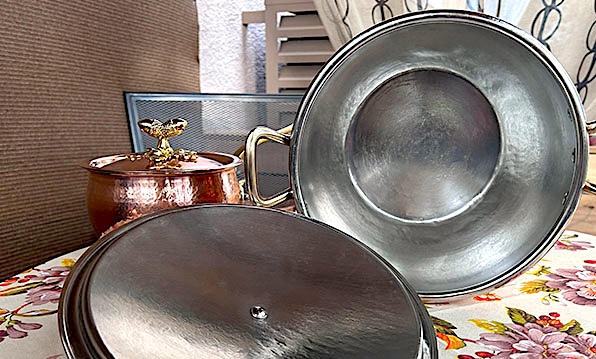TINNING, RE-TINNING & WHY
You’ve made an excellent choice to invest in copper cookware. Not only is it beautiful to look at, but it saves you valuable cooking time and ultimately – money.
Here is how
Because of the excellent conductive qualities of both copper and tin, it takes very little time for the cookware to reach the desired temperature and transfer the heat directly to the food that is being prepared in it. In comparison with Cast Iron or Stainless Steel cookware, your food will be ready in at least half the time.
Of-course, cast iron and stainless steel have their own place in your kitchen, as they come with a set of benefits no other cookware can provide. However, in fast paced kitchens there is no match for copper. No wonder vast majority of reputable food establishments use copper cookware in their kitchen.

So, Why Tin?
The process of tinning metal to prevent it from rusting dates back centuries and has been honed over time and adjusted to meet the requirements of the specific application. We tin copper cookware (pots, pans, bowls and kettles) to prevent them from developing oxidation and verdigris that can spoil your food, and, if ingested in certain quantities, harm your health.
There are two major methods of tinning available today:
1. Traditional (hand wiped);
2. Electroplated.
There are advantages and disadvantages in both methods.
The traditional (hand wiped) method involves high heat, acid, flux and tin.
In this application, tin is brought to its melting point and applied to the surface using a thick piece of rag or suede. This is where the name “hand wiped” comes from.
Electroplating, on the other hand, is achieved using electrolyte and electrical current. This application provides a shiny, even and absolutely seamless coat of tin.
PROS:
The Traditional Method provides a thick, shiny coat of tin that gives your cookware a long life between re-tins and is ideal for daily use.
The Electroplating method provides an even, seamless coat of tin which looks terrific, if used rarely.
CONS:
The Traditional method leaves slight wipe marks which are not visible to a naked eye, however can be seen upon close inspection.
The Electroplating method applies a relatively thin layer of tin which wares off faster and requires more frequent re-tinning.
Here at Copper Tinner we use the Traditional Tinning Method, as we strive to provide our customers with long-lasting results, saving them valuable time and money.
